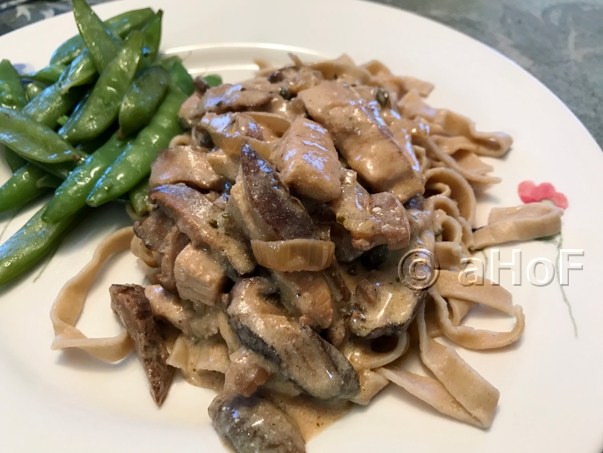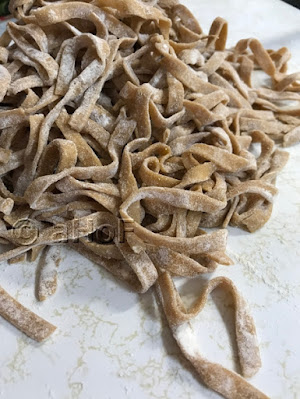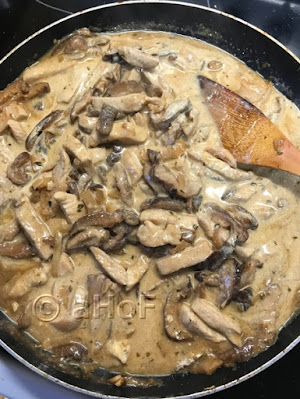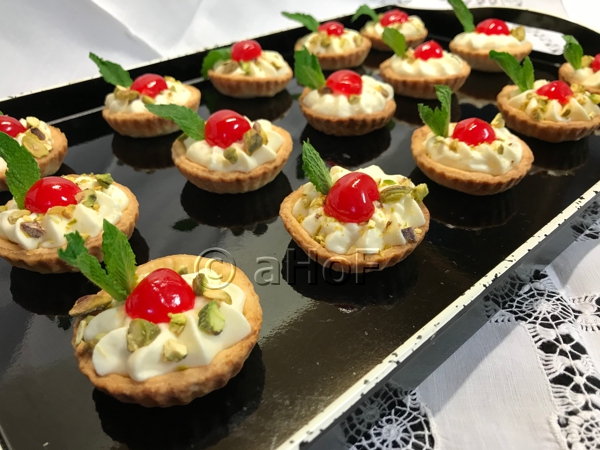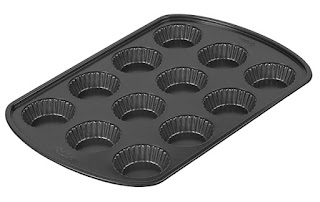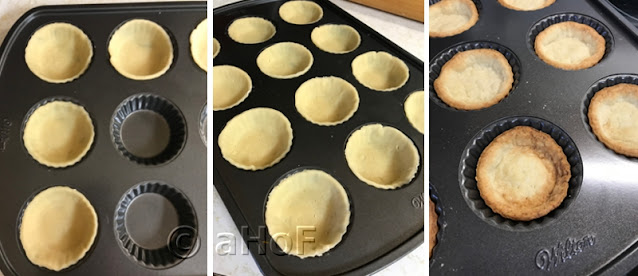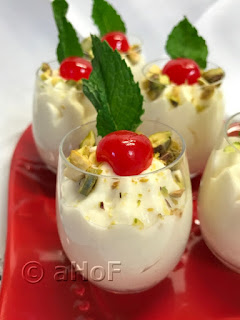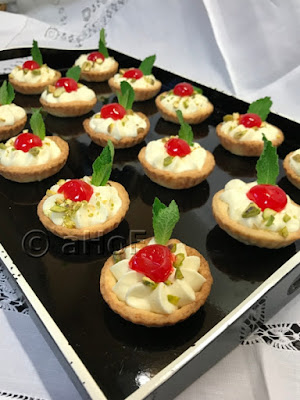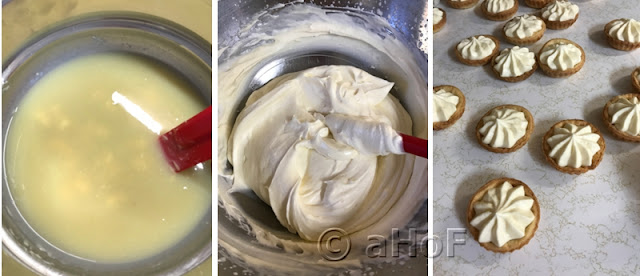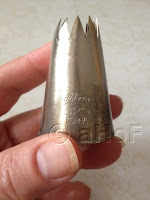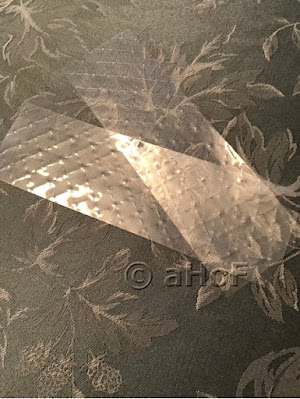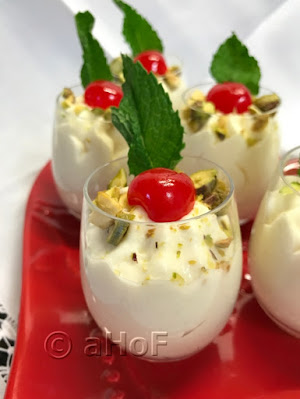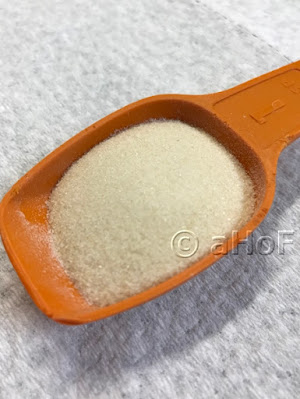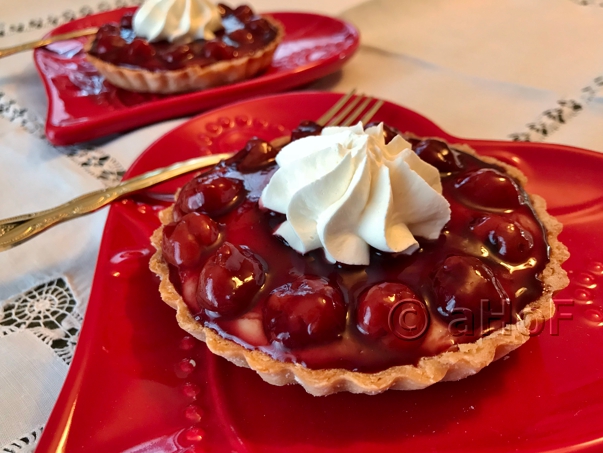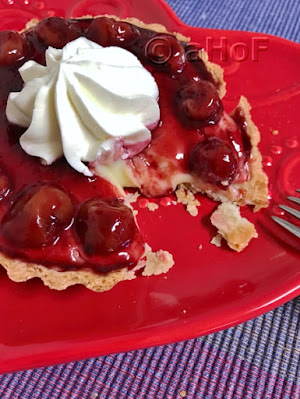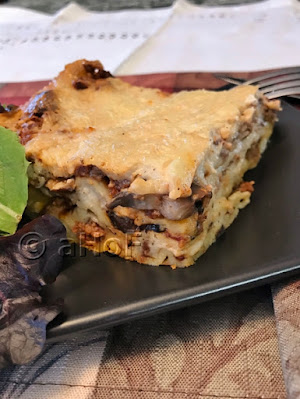Since that time, I have made a couple of other breakfast casseroles, in the same little Pyrex 2-serving sized loaf pan. I've learned a few things along the way. Chief among these things is that covering the casserole during baking makes the baking time decrease, and also the egg puffs beautifully. That first attempt in November was the first time I had ever made a breakfast egg casserole of any kind.
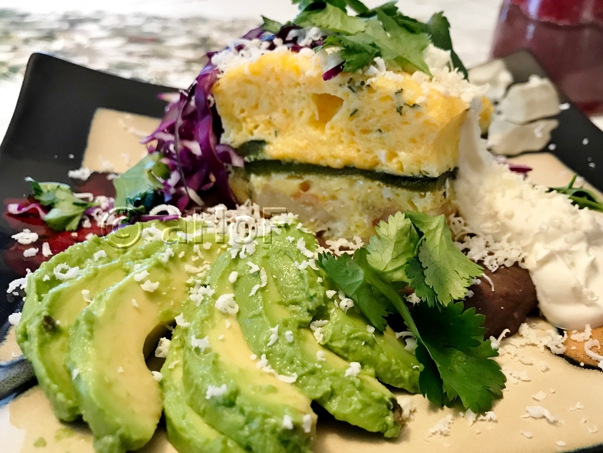 |
| Poblano Relleno Breakfast Casserole II |
Another idea that came up while making these other casseroles (without the Poblano pepper in the middle) is that adding shredded cheese to the egg that goes atop the Poblano might just help the egg keep the Poblano down, just above the potatoes in the bottom, instead of floating to the top as it did in my first attempt. At Tweets, the Poblano was just perfectly set above the potatoes in the bottom of the casserole, while the top half of the eggs was set nice and high above. In my first attempt in November, I had not added any cheese to the eggs that went over top of the Poblano pepper, and both the potatoes and the Poblano layer just floated up to the surface.
 A few years back I had bought some pretty silicone lids by Charles Viancin, in a kitchen store (Amazon carries them, thus the link. i have no affiliation with Amazon or any remuneration for selling them). My first couple were "lily pad" shaped, and then I got a couple of banana leaf types. I love these, either for covering a plate while reheating in the microwave, or while baking things in the oven. I use the larger rectangle banana leaf shape to cover my scalloped potatoes while they bake, and I found that the medium sized lily pad lid covers this little Pyrex loaf pan. And the best part of all is that since the silicone is flexible, it expands as the eggs expand. I haven't tried this with anything else as a cover, since it works so perfectly. And since the eggs tend to puff way up, I would be hesitant to use something like aluminum foil. Just below is a photo of one of my other breakfast casseroles, just baked, with the Lily Pad lid removed.
A few years back I had bought some pretty silicone lids by Charles Viancin, in a kitchen store (Amazon carries them, thus the link. i have no affiliation with Amazon or any remuneration for selling them). My first couple were "lily pad" shaped, and then I got a couple of banana leaf types. I love these, either for covering a plate while reheating in the microwave, or while baking things in the oven. I use the larger rectangle banana leaf shape to cover my scalloped potatoes while they bake, and I found that the medium sized lily pad lid covers this little Pyrex loaf pan. And the best part of all is that since the silicone is flexible, it expands as the eggs expand. I haven't tried this with anything else as a cover, since it works so perfectly. And since the eggs tend to puff way up, I would be hesitant to use something like aluminum foil. Just below is a photo of one of my other breakfast casseroles, just baked, with the Lily Pad lid removed.
At this point in time, I have become quite proficient at making these breakfast casseroles, and they are turning out great every time. I tried making this recipe in two wells of a jumbo muffin tin, and while they came out well, perfectly cooked, I just didn't like it. Why? Because I do not like any brown on my eggs. I cannot tolerate the flavor of browned egg. When I make this casserole in the small loaf pan, once removed from the pan, I trim all the edges so they are perfectly straight, thereby removing any browned sides. In the muffin tin, being round, I did no trimming, and all those browned sides just totally ruined the flavor, for me.
I realize that while I am not unique in this particular dislike, there are also plenty of people who absolutely prefer their eggs browned, or even slightly burnt. If this is the case, go for the jumbo muffin tins, as they came out great, aside from this one flaw (for me 😀).
Ultimately, here below I am showing a photo of my scrumptious breakfast at Tweets, then my first attempt at recreating this casserole at home, and then my second attempt, recently, where finally I got it just as I wanted it. The cheese was added to the second half of the eggs, and pouring this over the Poblano kept enough bulk in the eggs to hold down the potato and Poblano. Just like at Tweets. Hurray!
 A few years back I had bought some pretty silicone lids by Charles Viancin, in a kitchen store (Amazon carries them, thus the link. i have no affiliation with Amazon or any remuneration for selling them). My first couple were "lily pad" shaped, and then I got a couple of banana leaf types. I love these, either for covering a plate while reheating in the microwave, or while baking things in the oven. I use the larger rectangle banana leaf shape to cover my scalloped potatoes while they bake, and I found that the medium sized lily pad lid covers this little Pyrex loaf pan. And the best part of all is that since the silicone is flexible, it expands as the eggs expand. I haven't tried this with anything else as a cover, since it works so perfectly. And since the eggs tend to puff way up, I would be hesitant to use something like aluminum foil. Just below is a photo of one of my other breakfast casseroles, just baked, with the Lily Pad lid removed.
A few years back I had bought some pretty silicone lids by Charles Viancin, in a kitchen store (Amazon carries them, thus the link. i have no affiliation with Amazon or any remuneration for selling them). My first couple were "lily pad" shaped, and then I got a couple of banana leaf types. I love these, either for covering a plate while reheating in the microwave, or while baking things in the oven. I use the larger rectangle banana leaf shape to cover my scalloped potatoes while they bake, and I found that the medium sized lily pad lid covers this little Pyrex loaf pan. And the best part of all is that since the silicone is flexible, it expands as the eggs expand. I haven't tried this with anything else as a cover, since it works so perfectly. And since the eggs tend to puff way up, I would be hesitant to use something like aluminum foil. Just below is a photo of one of my other breakfast casseroles, just baked, with the Lily Pad lid removed.| Bacon and Egg Casserole |
I realize that while I am not unique in this particular dislike, there are also plenty of people who absolutely prefer their eggs browned, or even slightly burnt. If this is the case, go for the jumbo muffin tins, as they came out great, aside from this one flaw (for me 😀).
Ultimately, here below I am showing a photo of my scrumptious breakfast at Tweets, then my first attempt at recreating this casserole at home, and then my second attempt, recently, where finally I got it just as I wanted it. The cheese was added to the second half of the eggs, and pouring this over the Poblano kept enough bulk in the eggs to hold down the potato and Poblano. Just like at Tweets. Hurray!
 |
| Tweets breakfast - my first attempt - my second attempt |
Poblano Relleno Breakfast Casserole II
Serves 2
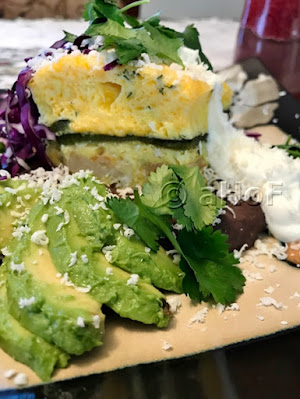 |
| Poblano Relleno Breakfast Casserole II |
MAKE AHEAD (one day, at least):
1 Poblano Pepper, blistered, peeled
2 cups black beans (cooked ahead or use one can, divided between plates)
CASSEROLE:
1 medium potato, quartered, sliced thinly
- oil for frying
¼ to ½ teaspoon salt for potatoes
6 eggs, whisked to combine
1 teaspoon fresh thyme leaves
½ teaspoon salt
½ cup shredded Cheddar cheese (or any preferred shredded cheese)
ASSEMBLE GARNISHES:
1 small "salad" portion, per plate (red cabbage, salad greens, arugula, etc)
2 - 4 small cherry tomatoes, or whatever colorful garnish is available
- sour cream, thinned if needed
- scallion greens, sliced or chopped
- cilantro leaves, optional
- Feta Cheese or Queso Fresco (1-ounce per plate)
Fry the potatoes in enough oil so they do not stick, and sprinkle with the ¼ to ½ teaspoon salt. Toss them frequently, until they are nicely browned, crisp and cooked through.
Spray a small loaf pan (4 x 6-inch) with cooking spray. Press the potatoes into the bottom of the casserole. Whisk the fresh thyme leaves and the ½ teaspoon salt into the eggs. Pour half the egg mixture over the potatoes and rap the pan various times to get the egg to penetrate the potatoes. Allow to set for a few minutes, while this occurs. Cut the peeled Poblano in half lengthwise, then set the halves over top of the potatoes so they cover the whole surface. Add the half cup Cheddar cheese to the remaining eggs and pour this over top of the Poblano pepper. Spray a silicone "lid" as explained above and set it over top of the casserole. Alternately, spray a piece of foil and set the sprayed side down over the casserole, but do not crimp it into place. Bake the casserole in a preheated 350 degree oven for about 40 to 45 minutes. Check after 35 minutes, as all ovens are different.
While the casserole is baking, assemble all the garnish ingredients. Heat the black beans, whether homemade or canned. When the casserole is done, give it a few minutes to set, then run a knife around the edges and remove the casserole from the pan. With a very sharp knife, trim the outer edges straight and cut the casserole in half. Place about 1 cup of black beans into each of two large bowls. Set a slice of the casserole on top of the beans in each plate. Place a portion of salad or slaw on top of the casserole, then "scribble" some sour cream artfully over the whole plate. Set the tomato slices around the casserole, crumble on the cheese and strew with scallion greens and cilantro, if using. Serve immediately.
My passion is teaching people how to create a harmony of flavors with their cooking, and passing along my love and joy of food, both simple or exotic, plain or fancy. I continue my journey in ethnic and domestic cuisines, continuing my journey to explore diverse culinary experiences and hopefully to start you on a journey of your own. Join me also at A Harmony of Flavors on Facebook, and Pinterest.

